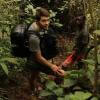Human-wildlife conflict is a shockingly common problem, often with enormous consequences for both individual animals and entire populations.
When human-wildlife conflict comes to mind, you may immediately think of wildlife crime instead - which isn't wrong, since many regions with wildlife crime problems like poaching are also areas where people may frequently deal with human-wildlife conflict, causing the two issues to go hand-in-hand. But human-wildlife conflict is a much broader issue encompassing many ways that human presence and interference can cause problems for us and animals alike. Human-wildlife conflict includes:
- Elephants trampling a farmer's crops, resulting in retaliation
- New real estate developments infringing on ecosystems where predator species live, leading to predators having less territory and less food, which in turn leads to predators attacking domestic animals and livestock
- Freeways dividing the territory of animals like mountain lions, leading to wildlife venturing into neighborhoods or being killed by cars
- Lead bullets used in hunting causing scavengers like condors to die of lead poisoning
These are just a few examples of how humans can negatively impact wildlife, and it's clear to see how many of these scenarios could escalate. Human-wildlife conflict solutions don't just include ways in which we can prevent these issues (for example, through tracking predators, monitoring populations' territories, or building barriers and wildlife crossings monitored by sensors), but also the ways in which we can help people connect with wildlife and care about learning to live alongside them.
If you're interested in solutions that can prevent human-wildlife conflict, join this group and get to know the people who are working to protect and save species around the world!
Header image: Casey Allen on Unsplash
- 0 Resources
- 0 Discussions
- 4 Groups
Freaklabs
I'm an engineer and product designer working on wildlife conservation technology.



- 0 Resources
- 271 Discussions
- 13 Groups
Founder & CEO of we.are.tohorā, creating a community that cares about whales, the environment and each other.
- 0 Resources
- 0 Discussions
- 13 Groups
- @StephODonnell
- | She / Her
WILDLABS
I'm the Community Manager at WILDLABS



- 150 Resources
- 656 Discussions
- 30 Groups
- @rokshanabushra
- | she/her
- 0 Resources
- 2 Discussions
- 1 Groups
- @mareesaislam
- | she/her
Conservation and Innovation Undergraduate Fellow
- 0 Resources
- 0 Discussions
- 2 Groups
- @Sarvagya
- | He/Him
- 0 Resources
- 0 Discussions
- 7 Groups
R & D Tech | Industrial Designer | Wildlife Management Technology



- 0 Resources
- 53 Discussions
- 1 Groups
Margo Supplies



- 0 Resources
- 18 Discussions
- 3 Groups
Wildlife Drones
Wildlife Drones has developed the world’s most innovative radio animal-tracking system using drones so you can track your radio-tagged animals like never before.

- 11 Resources
- 8 Discussions
- 32 Groups
- @sjmw71
- | she/her
Wildlife conservationist, writer, and photographer looking for a job in wildlife conservation! My "dream job" would involve adding a creative aspect (e.g., writing or photography) to promote the conservation of wildlife worldwide.
- 0 Resources
- 2 Discussions
- 3 Groups
- @rowan
- | they / them
Octophin Digital
Jack of all Trades. I've been a zoo keeper, a conservation geneticist and a web developer who specialises in conservation projects and orgs.
- 0 Resources
- 3 Discussions
- 15 Groups
The primary focus of the research is to explore how red deer movements, space use, habitat selection and foraging behaviour change during the wolf recolonization process.
10 February 2024
Article
An update on @Alasdair and @adanger24's HWC project
11 January 2024
Listen in on our interview with human-predator conflict expert, Gabi Fleury and gain a deeper understanding of the importance of holistic, ethical and community-led approaches to developing tech solutions for...
8 December 2023
TagRanger® is a state-of-the-art wildlife finding, monitoring and tracking solution for research, conservation and environmental professionals. With superior configurability for logging data, reporting location and...
23 November 2023
The illegal wildlife trade varies widely regarding species and geographical variance, necessitating niche and tailored research. Against this background, this study on elephant poaching in Tanzania was conducted at the...
30 October 2023
Careers
The Institute of Zoology (IoZ), the research division of the Zoological Society of London (ZSL), is seeking to fill three new permanent positions by recruiting outstanding early-career researchers as Research Fellows (...
20 October 2023
Listen in on our interview with Mara Elephant Project’s Tracking Manager, Wilson Sairowua, as he explains how MEP is using software, geofencing and drone technologies to resolve human-elephant conflict across Maasai...
20 October 2023
We're delighted to announce that Connected Conservation Foundation and Airbus Foundation have today launched round 2 of the ‘Satellites for Biodiversity Award’.
2 October 2023
Article
Five #tech4wildlife people, projects and updates that caught our attention this month. An AI supported bear early warning system, a project that's connecting indigenous communities with high speed internet, exploring...
12 September 2023
The WCS team in Uganda is working with impacted communities, district leaders and wildlife authorities to come up with innovative solutions to Human Wildlife Conflicts and curb wildlife crimes in our time. Check out...
5 September 2023
Read our interview with Sandra Maryanne, a young conservation tech innovator raised in Taita, Ivarenyi with first-hand experience on the challenges of human-elephant conflict within her community. To address this, she...
7 August 2023
Human-Wildlife Conflict is a pressing conservation challenge affecting natural ecosystems, biodiversity and local communities across East Africa. This has led to the development and adoption of diverse conservation...
1 August 2023
April 2024
event
October 2024
November 2023
event
| Description | Activity | Replies | Groups | Updated |
|---|---|---|---|---|
| Thank you Carly! We have over 60 bats recorded in Zimbabwe |
|
Citizen Science, Acoustics, Conservation Tech Training and Education, Human-Wildlife Conflict | 1 week 3 days ago | |
| That is an interesting concept, and it would be great if something out there worked. In the meantime, I will try not to drive at dusk 🦘At one point, I knew the "sonic" animal... |
|
Acoustics, Citizen Science, Community Base, Human-Wildlife Conflict | 1 week 3 days ago | |
| Hi @Henrikcox I hope you are well. I am not sure if you may remember myself and my colleague from CLS. We had a meeting and met in-person at Earthranger last year. ... |
+15
|
Human-Wildlife Conflict, Sensors | 3 weeks ago | |
| Great to know Lars! Let's stay in touch on this, would love to join the testing out there.Cheers,Henrik |
+68
|
Human-Wildlife Conflict | 3 weeks 1 day ago | |
| This thread is off-topic in this conversation, so happy to continue it in the other one. However, just noting - your system is one example, but not the only one - there are... |
|
Human-Wildlife Conflict, Data management and processing tools | 3 weeks 3 days ago | |
| Hello community, I wanted to share some exciting updates about my ongoing conservation project for endangered species. I post this here... |
|
Human-Wildlife Conflict, Early Career | 1 month ago | |
| Hi Rokshana,Maybe you can try this product from India called ANIDERS - I think this product would help you a lot. This is their website - |
|
Human-Wildlife Conflict, East Africa Community | 1 month 1 week ago | |
| Perfect thanks! I am still a novice using Python but my wife can help me! |
+6
|
AI for Conservation, Camera Traps, Human-Wildlife Conflict | 2 months ago | |
| @PaulAllin Thanks for your valuable insights. Zenmuse H20N seems to be very powerful and useful in this case. However, I'm looking for a more affordable option for a self-funded... |
+5
|
Drones, Human-Wildlife Conflict | 2 months ago | |
| Hi David, would love to collaborate with you on this topic. A few years ago Dr. Nick van Doormaal did his PhD on snaring with us and we ran a number of experiments on the... |
+4
|
AI for Conservation, Drones, Emerging Tech, Human-Wildlife Conflict, Wildlife Crime | 2 months ago | |
| Hi Amit,The most important thing is that the livestock owners contact you as soon as possible after finding the carcass. We commonly do two things if they contact us on the same... |
|
Camera Traps, AI for Conservation, Conservation Tech Training and Education, Early Career, Human-Wildlife Conflict, Protected Area Management Tools | 2 months 2 weeks ago | |
| Hi Danilo. you seem very passionate about this initiative which is a good start.It is an interesting coincidence that I am starting another project for the coral reefs in the... |
|
Acoustics, AI for Conservation, Biologging, Camera Traps, Citizen Science, Climate Change, Community Base, Connectivity, Drones, Emerging Tech, Human-Wildlife Conflict, Open Source Solutions, Sensors, Software and Mobile Apps, Wildlife Crime | 2 months 2 weeks ago |
CERES TAG
22 July 2022 3:36am
Hello there
1 July 2022 5:00pm
Temporarily marking of polar bears entering villages
27 November 2019 1:49pm
17 June 2022 8:09pm
Hi @Femke_Hilderink , long time no speak!
What an interesting problem/project!
Does it have to be paint, as there was this project a while back:
I don't know how it's going, but am really interested to hear anything...
If something like paint is preferable, maybe drones delivering it could work? I am super interested in using drones to drop tracking tags onto animals, and polar bears are big enough targets to give this a rip snorting go! Happy to discuss.
I had a colleague that used food dye to temporarily colour Australian ibis at refuse sites. If memory serves they trialled sprinklers and super soakers for delivery with some success. I can try and dig up more information if you like?
Or could their foot pads be painted, as maybe they could 'pick up the paint' by walking over an area with paint on the ground? That way their coats are left relatively untouched...
Looking forward to hearing other ideas!
Cheers,
Rob
International Platform to exchange knowledge and experiences about solutions/initiatives on Human-Wildlife conflict issues
31 January 2022 11:31am
31 January 2022 11:32am
Why this collaboration platform? What entails to become ENCOSH member?
Tackling human-wildlife coexistence issues requires an holistic approach with various initiatives/measures/strategies. Many of these have been tested in various places over the world by various stakeholders. But there is a lack of sharing these initiatives across the world. Besides, many could be adapted in various context and for different animal species. It is like a big puzzle with all pieces out there but spread out.
This is why this collaborative platform was created to gather all extant initiatives/measures/strategies and multi-stakeholders involved in these "solutions" to share their knowledge and experiences so that everyone can learn from each other and better tackling such issues locally.
Any user who registers on the platform becomes members, the only engagement is to accept the privacy policy and terms & conditions. Members can have access to all the platform features. They can also share their own initiatives/measures (not a whole project) if they want to contribute. This will create technical sheets that our team will first review before sharing on the platform and will be then available to all and downloadable in many languages for use in different countries and on the field.
Tech, Evidence and Financial Compensation for livestock losses due to predators
13 November 2020 4:03pm
20 November 2020 7:47pm
Chavoux....
BRILLIANT!
Regarding collaring, I am developing collars for livestock, not for Jaguars. BCB detects Jaguars using Smart Cameras (smart fences are on the plans as well) and that information is inside livestock collars, so you can get early alerts if domestic animals are in dangerous zones (people here release their animals for feeding, etc). If no Smart cameras are present, you can tag the areas manually if you have the evidence from camera trapping or inhabitants (I developed simple panic buttons as a way to engage local inhabitants). I was about to test all this however the pandemic imposed trip restrictions since the early days of March!
That's regarding tech. Your views on the human side are really interesting, I will talk about this soon with Conicet Researchers, I guess more synchronization with NGOs are needed, there are a lot of political things in the middle however, this sounds quite good to me: "predator friendly meat" brand, if you want, please drop me an email at [email protected] so I can get yours or subscribe to the BCB's site (The site is to try to encourage other people to use tech and talk about the Jaguar situation here, it is not for fundraising)
There are some simple things that can be done to make a huge difference, tech is only an enabler in my opinion. I collected a few tips also here (not mine, I'm a tech guy but I liked the drawings, they were made with love for Jaguars!)
www.wildedge.info/jaguarcampaigni
Warm regards Chavoux! I hope other people will read your words as well!
10 November 2021 2:02pm
Hello Carlos and Chavoux,
Interesting exchange, thank you! Working on HWC, boh locally on Human-Jaguar coexistence in French Guyana and globally through the ENCOSH platform, it would great to learn more from your initiatives and experiences!
An opportunity to do so is to join us and contribute to the ENCOSH platform: https://encosh.org/en/
It is a recent international collaborative platform to promote the exchange of knowledge, experiences and ideas among all stakeholders worldwide to better tackling Human-Wildlife coexistence issues. A forum will be very soon included also.
Your contribution would be meaningful by submitting some of your initiatives to this community. Besides, you could find and make comments on a list of almost 100 extant initiatives used to enhance Human-Wildlife interactions worldwide.
I remain available if you need further information or guidance.
All the best
Tommy Gaillard
3 December 2021 5:12pm
This is an awesome thread and very enlightening. Thank you! I started reading this as Oregon recently had an entire pack of wolves poisoned, and I wanted to understand the viewpoints that go into these conversations. Thank you!
Technical Difficulties: The Death of Giants
 Christie Sampson
Christie Sampson
3 November 2021 12:00am
EarthRanger Announces Inaugural Conservation Tech Award Recipients
 EarthRanger
EarthRanger
3 November 2021 12:00am
Technical Difficulties: A Deployment Checklist
 Alina Peter
Alina Peter
13 October 2021 12:00am
Incubating grassroots innovations (tech/non-tech) to mitigate conflict
16 August 2021 8:55am
Tech4Wildlife Leaders: Understanding Endangered Primate Populations
 Tasmin Alexander
Tasmin Alexander
2 June 2021 12:00am
Tech4Wildlife Leaders: Resolving Human-Giraffe Conflict
 Owino Raymond
Owino Raymond
21 May 2021 12:00am
Margo Gadfly: A Versatile Wildlife Deterrent
 Margo Supplies
Margo Supplies
31 March 2021 12:00am
Warn elephants using infrasound?
25 April 2018 1:30pm
17 March 2021 11:22am
Good day Lily.
I stumbled upon this post of yours.
Have you been able to make any advancement on this topic, or get any feedback from anyone?
I have been asked a similar question by a group, looking at early warning systems for large mammals, like elephants, of possible danger situations.
On my side, it is still a very new project, however, my use case has more to do with the trains that kills the elephants, but we also have a use case for early warning systems to recognize poachers and early warning systems to intercept any possible threat.
So if you are in a position, and willing to share any information, I would like to find out more, if there has been any developments regarding this topic aon your side.
Kind regards
Mischa
26 March 2021 4:23pm
Hi,
Generating infrasound is generally energy intensive and expensive. You can google "infra-subwoofer" and despair at the prices! But those are for audiophiles. I came across a fan type speaker design a long time ago that I think can be adapted, Another possibility is to use pyrotechnics to generate infrasound, but that would not be reusable and I suspect development will be even more of a headache. An intriguing possibility is to use basically a fogger - - those noisy smoky fumigators -- but built to produce the lower frequency.
26 March 2021 4:25pm
You should check out Smart Parks (https://www.smartparks.org/) and Hack the Poacher (https://www.hackthepoacher.com/).
Also -
Fazil, M., & Firdhous, M. (2018, December). IoT-enabled smart elephant detection system for combating human elephant conflict. In 2018 3rd International Conference on Information Technology Research (ICITR) (pp. 1-6). IEEE.
Shaffer, L. J., Khadka, K. K., Van Den Hoek, J., & Naithani, K. J. (2019). Human-elephant conflict: A review of current management strategies and future directions. Frontiers in Ecology and Evolution, 6, 235.
That last paper is a nice overview of different methods, and they have a section on acoustic strategies.
Webinar: 'Advances in use of SMART approach, tools and technology'
 The SMART Partnership
The SMART Partnership
12 March 2021 12:00am
How do I strategically allocate drones for conservation?
8 February 2021 12:00am
Predator Deterrent - Human Effigy Based
3 October 2020 2:15am
Audio play back device when elephant crop raids
7 November 2019 7:55am
23 September 2020 7:27am
I've worked on a similar project to try to scare lions away from bomas in Kenya that's pretty much a bunch of stuff from Adafruit rigged together with cheap marine speakers in an overly complicated custom case (picture is of previous generation, new generation in development). We also run LEDs to show various light displays. I imagine you could imitate a muzzle flash to deepen the illusion of gunfire. I'm also happy to discuss things (although I don't think I can match the technical expertise of Freaklabs).

27 September 2020 1:57am
Suraci et al. have published a few papers about the use of an automated behavioral response system for sound playback when triggered by a camera trap. Their methods (see supplementary materials) are entirely open source and I even commissioned an engineer to make a few for me. The only issue is that the MP3 players need a separate battery pack to keep them charged or need to be charged weekly, as the sound runs continuosly since there would otherwise be a delay between the camera trigger and the MP3 player being turned on. This could probably be fiddled with to suit your needs, if the previous options don't work out.
https://besjournals.onlinelibrary.wiley.com/doi/10.1111/2041-210X.12711
27 September 2020 3:31am
We actually designed Boombox, the audio player shown above, based on the ABRS system by the Suraci paper and with Dr. Meredith Palmer. We made some optimizations on it since the paper advocates an approach to infer when the camera was triggered. We reverse engineered our camera traps and took the actual trigger signal from the trailcam PIR motion sensor. Later, we were contacted by one of the authors of the paper and he mentioned they had come to the same conclusion.
We built the MP3 playback system using a discrete MP3 decoder IC which allowed us more control over playback, power management, and we could pick out the output amplifier to drive the speakers. We knew we would need to put the system to sleep and immediately play sounds on wakeup which most players aren't suited to do.
We also made it so that it's solar rechargeable with lithium-ion batteries so that it could last in the field as long as possible. Unfortunately we couldn't use that feature because there's no point in outlasting the trailcams. But for this application, it seems we might be able to use the solar recharging functionality.
We've volunteered for a possible TechTutors season 2 workshop on open source MP3 playback and recording with Arduino. We're waiting to discuss it with Steph and Ellie. If this sounds interesting, please let us know.
Challenge: ElephantEdge
 hackster.io
hackster.io
11 August 2020 12:00am
Grassroots Innovations for Wildlife Conservation
 Aditya Gangadharan
Aditya Gangadharan
19 May 2020 12:00am
Get To Know FIT
6 May 2020 12:00am
Era of the Condor: A Species' Future in Recovery
 Ellie Warren
Ellie Warren
5 May 2020 12:00am
Locally-Brewed Conservation Technology from a Small Town in North Bengal
 Aditya Gangadharan
Aditya Gangadharan
10 April 2020 12:00am
Technology Showroom of Artificial Intelligence (AI) aided Elephant Early Warning Systems
6 March 2020 6:09pm
19 March 2020 9:15am
Hi @Tim+Vedanayagam
Thank you for posting this. I'd be happy to contribute to the thermal sensing work under way. Can you confirm - have you built a thermal AI model and trained / labelled data for a particular camera?
We have been training a model for low cost (Lepton 3.5) thermal cameras via a challenge with WWF / Wildlabs and have 30,000 labelled images as our training dataset of Asian elephants. We're focusing on Deeplabel and YOLO with a plan to port to Tensorflow and it will be open source, so applicable for others to use and adopt in their early warning systems that use thermal.
More info here - https://www.zsl.org/blogs/conservation/zsl-whipsnade-zoo-becomes-a-space-for-high-tech-wild-elephant-conservation
Kind regards,
Alasdair
Webinar: IIED Community-Based Approaches to Tackling Poaching and Illegal Wildlife Trade
 IIED
IIED
17 March 2020 12:00am
Testing an Early Warning System to Mitigate Human-Wildlife Conflict on the Bhutan-India Border
 Aditya Gangadharan
Aditya Gangadharan
11 March 2020 12:00am
3 Ways Your Conservation Technology Could Become a Shiny Pile of Junk, and How to Avoid It
 Aditya Gangadharan
Aditya Gangadharan
9 March 2020 12:00am
Accepting Applications: ArcGIS Solutions for Protected Area Management
 esri
esri
4 March 2020 12:00am
#Tech4Wildlife 2020 Photo Challenge In Review
4 March 2020 12:00am
Call for Nominations: Tusk Conservation Awards
 Tusk
Tusk
3 March 2020 12:00am
Fence-Based Elephant Early Warning System
 Appiko
Appiko
25 February 2020 12:00am























































3 June 2022 2:49pm
Hi Femke, did you get any responses to this question? If so I would be interested in hearing what came up.
Long ago I was trapping small mammals and we would use picric acid (fluorescent yellow) to dye the hair on the bellies of mice and voles. It is a bit explosive esp if it drys out but we never had any issues of that sort. Maybe there is a safe and stable form that could be deployed via paint gun - I seem to recall that the Polar Bear Alert Team in Churchill Manitoba tested paintballs on polar bears but not sure of the results.
Stephen